Microplastic pollution in the Mohawk River Watershed
My students and I are investigating the occurrence of microplastic pollution (plastic particles <5 mm in length) in the lower Mohawk River watershed. In 2016 we collected 63 trawl samples and 64 sediment samples in the Mohawk River and Erie Canal between Rome and Cohoes, NY. Every sample contained microplastic particles, indicating that microplastics are pervasive in the Mohawk River.
In June-July 2018 we sampled 21 Mohawk tributaries and the Mohawk River in Rome, NY, for microplastics. Sampling was performed under low-flow conditions at all sites except for the Hans Groot Kill on Union College’s campus, which was sampled once during low-flow conditions and once during a heavy downpour (see photo below). The high-flow Hans Groot Kill sample has >7,000 microplastic particles in it, whereas the low-flow sample has just 72!
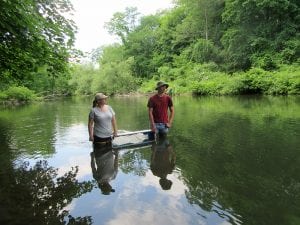
Sampling the Mohawk River in Rome, NY. Undergraduate researchers Emily Caruso (left) and Nick Wright (right) hold the net.
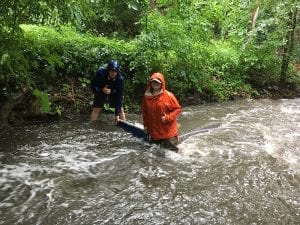
Sampling the Hans Groot Kill on the Union College campus during a rainstorm. Nick Wright (left) and Emily Caruso (right) hold the net in place under high-flow conditions.
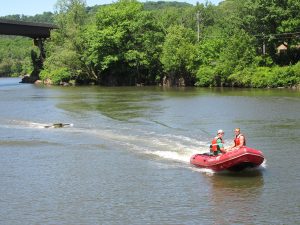
Collecting a sample of floating material in the Mohawk River at Little Falls using the manta trawl, July 2016.
Talks:
I gave an online talk titled “Microplastic pollution in the Mohawk River Watershed” on Oct. 15, 2020, for the Albany Pine Bush Preserve’s Science Lecture Series. The video can be found here (video opens in this page): Link to video
Press:
Our microplastics research is featured in the Spring 2018 issue of Union College Magazine. pdf
Abstracts:
Smith, J.A., Caruso, E., and Wright, N., 2020, Microplastic pollution in Mohawk River tributaries: likely sources and potential implications for the Mohawk Watershed, in Garver, J.I., Smith, J.A., and Rodak, C., Proceedings of the 2020 Mohawk Watershed Symposium, Union College, Schenectady, NY, March 20, 2020 (cancelled), v. 12, 74 p., p. 53-58. PDF
Willard-Bauer, E., Smith, J.A., Garver, J.I., Goldman, D., and Newcomer, B., 2020, Enterococci levels in the Hans Groot Kill and Mohawk River, Schenectady, NY, in Garver, J.I., Smith, J.A., and Rodak, C. 2020, Proceedings of the 2020 Mohawk Watershed Symposium, Union College, Schenectady, NY, March 20, 2020 (cancelled), v. 12, 74 p., p. 63-67. PDF
Smith, J.A., Caruso, E., and Wright, N., 2019, Extreme rainfall, high water, and elevated microplastic concentration in the Hans Groot Kill: implications for the Mohawk River, in Garver, J.I., Smith, J.A., and Rodak, C., Proceedings of the 2019 Mohawk Watershed Symposium, Union College, Schenectady, NY, March 22, 2019, vol, 11, 74 p., p. 54-59. PDF
Smith, J.A., Caruso, E., and Wright, N., 2018, Microplastic pollution in tributaries of the Mohawk River, New York State (abstract): 2018 Geological Society of America Annual Meeting, Indianapolis, IN (4-7 November 2018), Paper 319620.
Smith, J.A. , Hodge, J.L., Kurtz, B.H., and Garver, J.I., 2018, Microplastic pollution in the main channel of the Mohawk River: final results of the 2016 sampling program, in Cockburn, J.M.H. and Garver, J.I., Proceedings of the 2018 Mohawk Watershed Symposium, Union College, Schenectady, NY, 23 March 2018, v. 10, p. 69-73.
Smith, J.A., Hodge, J.L., Kurtz, B.H., and Garver, J.I., 2017, Pervasive microplastic pollution found in the Mohawk River, New York State: 2017 Geological Society of America Annual Meeting, Seattle, WA (22-25 October, 2017), Paper No. 94-8.
Smith, J.A., Hodge, J.L., Kurtz, B.H., and Garver, J.I., 2017, The distribution of microplastic pollution in the Mohawk River in Cockburn, J.M.H. and Garver, J.I., 2017. Proceedings of the 2017 Mohawk Watershed Symposium, Union College, Schenectady, NY, March 17, 2017, v. 9, 75 p., p. 67-71. (PDF)
Smith, J.A., Garver, J.I., Hodge, J.L., and Kurtz, B.H., 2017, Fly ash and coal ash in the Mohawk River in Cockburn, J.M.H. and Garver, J.I., 2017. Proceedings of the 2017 Mohawk Watershed Symposium, Union College, Schenectady, NY, March 17, 2017, v. 9, 75 p., p. 63-66. (PDF)
River terraces along the Rio Grande, south-central Colorado
In 2014, Dr. Brad Johnson (Davidson College) and I shifted our focus to the age and origin of river terraces along the South Fork and the main branch of the Rio Grande in south-central Colorado. We started a fruitful collaboration with Dr. Jared Beeton (formerly at Adams State University in Alamosa, CO; now at Fort Lewis College, Durango, CO) and joined him and his students in the field in July 2014. We mapped terraces and collected samples for radiocarbon and OSL dating. Results of the radiocarbon dating indicate that the youngest of the four main terrace levels we identified formed at least 3000 years ago and was active as recently as 700 years ago.
Abstracts:
Ivers, K.J., Beeton, J.M., Smith, J.A., and Johnson, B.G., 2016, Soils and geoarchaeology of the Upper Rio Grande Basin, San Juan Mountains, Colorado: 2016 Geological Society of America Annual Meeting, Denver, CO (25-28 September 2016), Paper No. 147-12.
Simmons, C., Ott, C., Beeton, J. M., Johnson, B. G., and Smith, J. A., 2016, Geomorphology of terraces and moraines in the upper Rio Grande basin, San Juan Mountains, Colorado, USA: 2016 Geological Society of America Annual Meeting, Denver, CO (25-28 September 2016), Paper No. 50-5.

Dr. Brad Johnson (left), Dr. Jared Beeton (center), and students from Davidson College, Adams State University, and The College of Saint Rose collecting soil samples from a river terrace along the South Fork of the Rio Grande, CO, 2014.
Post-glacial landscape development in the San Juan Mountains, Colorado
I worked with Dr. Brad Johnson (Davidson College) and Dr. John Diemer (UNC Charlotte) on a project aimed at understanding landscape evolution in the southeastern San Juan Mountains of southern Colorado and northern New Mexico. We used a three-pronged approach to determining the timing of landsliding events following deglaciation in the region: coring bogs, analyzing soil development, and sampling boulders for surface exposure dating. Our results show a range of landslide ages from ~14 ka to ~3 ka on four landslides and suggest an important role for precipitation variations in triggering landslides in the region.
Johnson, B.G., Smith, J.A., and Diemer, J.A., 2017, A chronology of post-glacial landslides suggests that slight increases in precipitation could trigger a disproportionate geomorphic response: Earth Surface Processes and Landforms, doi: 10.1002/esp.4168. 2018 Wiley Award Winner (awarded by British Society for Geomorphology for best paper published in Earth Surface Processes and Landforms in 2017)
Johnson, B.G., Diemer, J.A., and Smith, J.A., 2018, Disproportionate geomorphic responses to precipitation in post-glacial landslides (Wiley Award Talk): British Society for Geomorphology Annual Meeting, 10-12 September 2018, Aberystwyth University, Aberystwyth, Wales, UK.
Influence of Heinrich events on glaciation in the Cordillera Blanca, Peru
We used surface exposure dating (10Be) to date moraines at Nevado Jeulla Rajo (NJR) at the southern end of the Cordillera Blanca in central Peru (10 S, 77.3 W). The largest moraines are late-glacial (~16 ka) and largely overrode local LGM moraines (~30 ka). A fortuitous change in ice-flow direction resulted in preservation of cross-cut older moraines (~40-65 ka) that provide locally rare evidence of MIS 3-4 glacial advances. The timing of glacial advances suggests a link to increased precipitation during Heinrich Events. The Cordillera Blanca Normal Fault borders the western side of the massif and offsets moraine crests, offering the opportunity to investigate longterm rates of movement along the fault.
Smith, J. A., and Rodbell, D.T., 2010, Cross-cutting moraines reveal evidence for North Atlantic influence on glaciers in the tropical Andes: Journal of Quaternary Science, v. 25, p. 243-248. (PDF)
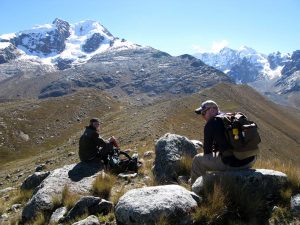
Late-glacial (~16 ka) right-lateral moraine (M3) in Jeullesh Valley, Nevado Jeulla Rajo, Peru, 2011.

Shaded topographic map of NJR study area showing dated moraine crests (M1-M9) and sample locations. Gray arrows indicate likely ice-flow directions during glacial advances. Yellow band shows observed exposures of diamicton in stream channel; diamicton is interpreted as lodgement till.
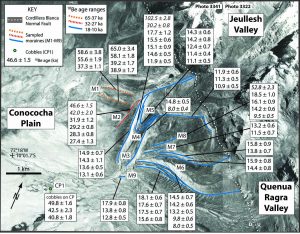
Aerial photos of NJR study area showing 10Be ages (zero-erosion) and external uncertainties in thousands of years before present (ka) for boulders on moraines (M1-M9) and cobbles on Conococho Plain (CP).
Early local last glacial maximum in the Peruvian Andes
My PhD research focused on the glacial record in valleys bordering Lake Junin (11 S, 76 W) in the central Peruvian Andes. I used surface exposure dating with in situ cosmogenic isotopes (10Be) to determine that the local last glacial maximum (LGM) occurred ~30 ka, earlier than the global LGM, and that previous glacial advances were far more extensive than the local LGM. A late-glacial advance or stillstand ~16 ka was nearly as extensive as the local LGM advance.
Smith, J.A., Seltzer, G.O., Rodbell, D.T., Farber, D.L., and Finkel, R.C., 2005, Early local last glacial maximum in the tropical Andes: Science, v. 308, p. 678-681. (PDF)
Smith, J.A., Finkel, R.C., Farber, D.L., Rodbell, D.T., and Seltzer, G.O., 2005, Moraine preservation and boulder erosion in the tropical Andes: interpreting old surface exposure ages in glaciated valleys: Journal of Quaternary Science, v. 20, p. 735-758. (PDF)
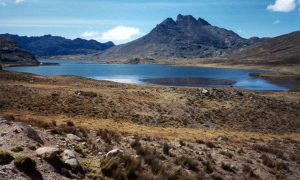
Late-glacial moraine (group B) damming Alcacocha Lake, Alcacocha Valley, east side of Lake Junin, Peru.

Figure 2 A-B. Exposure ages of moraines in the Junin valleys (A) and Milluni and Zongo Valleys (B) based on cosmogenic dating with 10Be.
Publications
Johnson, B.G., Smith, J.A., and Diemer, J.A., 2017, A chronology of post-glacial landslides suggests that slight increases in precipitation could trigger a disproportionate geomorphic response: Earth Surface Processes and Landforms, doi: 10.1002/esp.4168.
Rodbell, D.T., Frey, H.M., Manon, M.R.F., Smith, J. A., McTurk, N.A. 2012, Development of unusual rock weathering features in the Cordillera Blanca, Peru: Quaternary Research, v. 77, p. 149-158. (PDF)
Smith, J. A., and Rodbell, D.T., 2010, Cross-cutting moraines reveal evidence for North Atlantic influence on glaciers in the tropical Andes: Journal of Quaternary Science, v. 25, p. 243-248. (PDF)
Wang, A., Garver, J.I., Wang, G., Smith, J.A., and Zhang, K., 2010, Episodic exhumation of the Greater Himalayan Sequence since the Miocene constrained by fission track thermochronology in Nyalam, central Himalaya: Tectonophysics, v. 495, p. 315-323. (PDF)
Rodbell, D.T., Smith, J.A., and Mark, B.G., 2009, Glaciation in the Andes during the Late Glacial and Holocene: Quaternary Science Reviews (Special issue on Holocene glaciers), v. 28, p. 2165-2212. (PDF)
Hall, S.R., Farber, D.L., Ramage, J.M., Rodbell, D.T., Finkel, R.C., Smith, J.A., Mark, B.G., and Kassel, C., 2009, Geochronology of Quaternary glaciations from the tropical Cordillera Huayhuash, Peru: Quaternary Science Reviews, v. 28, p. 2991-3009. (PDF)
Wang, A., Smith, J.A., Wang, G., Zhang, K., Xiang. S., and Liu, D., 2009, Late Quaternary river terrace sequences in the eastern Kunlun Range, northern Tibet: A combined record of climatic change and surface uplift; Journal of Asian Earth Sciences, v. 34, p. 532-543. (PDF)
Zech, R., Smith, J.A., and Kaplan, M., 2009, Chronologies of the LGM and its termination in the Andes based on surface exposure dating (Chapter 3): Springer – Developments in Paleoenvironmental Research Series (DPER), Vol. 14 – Past climate variability from the Last Glacial Maximum to the Holocene in South America and Surrounding regions, Vimeux, F., Sylvestre, F., and Khodri, M. (Editors)
Smith, J.A., Mark, B.G., and Rodbell, D.T., 2008, The timing and magnitude of mountain glaciation in the tropical Andes: Journal of Quaternary Science, v. 23, p. 609-634. (PDF)
Rodbell, D.T., Seltzer, G.O., Mark, B.G., Smith, J.A., and Abbott, M.B., 2008, Clastic sediment flux to tropical Andean lakes: records of glaciation and soil erosion: Quaternary Science Reviews, v. 27, p. 1612-1626. (PDF)
Smith, J.A., Seltzer, G.O., Rodbell, D.T., Farber, D.L., and Finkel, R.C., 2005, Early local last glacial maximum in the tropical Andes: Science, v. 308, p. 678-681. (PDF)
Smith, J.A., Seltzer, G.O., Rodbell, D.T., and Klein, A.G., 2005, Regional synthesis of last glacial maximum snowlines in the tropical Andes, South America: Quaternary International, v. 138-139, p. 145-167. (PDF)
Smith, J.A., Finkel, R.C., Farber, D.L., Rodbell, D.T., and Seltzer, G.O., 2005, Moraine preservation and boulder erosion in the tropical Andes: interpreting old surface exposure ages in glaciated valleys: Journal of Quaternary Science, v. 20, p. 735-758. (PDF)
Ramage, J.M., Smith, J.A., Rodbell, D.T., and Seltzer, G.O., 2005, Comparing reconstructed Pleistocene equilibrium line altitudes in the tropical Andes of central Perú: Journal of Quaternary Science, v. 20, p. 777-788. (PDF)





